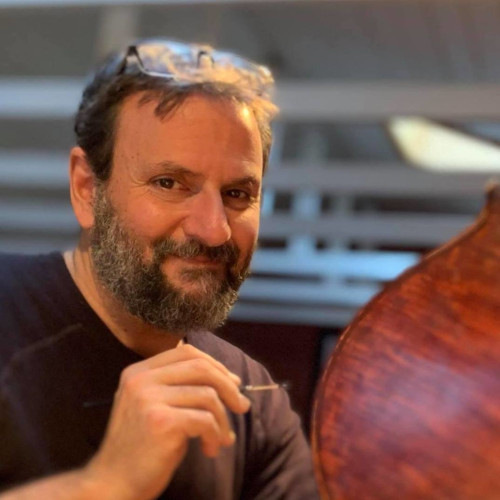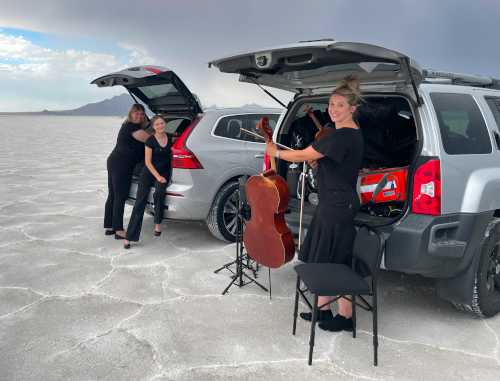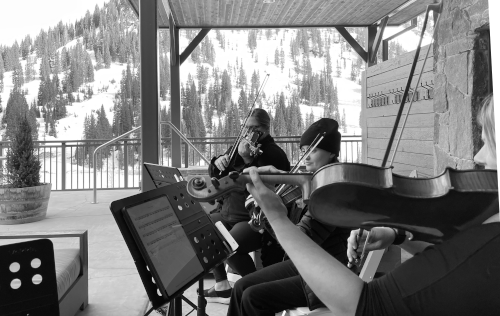Why String Quartet Requests Are What They Are

Why do string quartets and other classical ensembles ask for the things they do when performing for your event?
In order to answer this question we needed more opinions and advice than just our own. JP Lucas, a luthier in Salt Lake City, UT, was kind enough to grant us an interview where we asked him questions specifically regarding the requests of a string quartet at outdoor venues. A luthier is someone who makes and/or maintains and fixes string instruments.
We will go though all the outdoor-specific requirements from our contract as well as some of the financial and logistical things. These will be pretty consistent across any string quartet you hire. Our hope in writing this article is to help our clients understand why we ask for these things and also help other quartets with their outdoor ventures with their clients as well.
As with many warnings and contracts, these things have appeared over time in our contract based on experiences. The images of our group members on this post are some of the real life moments that prompted these line items in our contract.
About our guest luthier JP Lucas

First, let's introduce our luthier! JP Lucas made his first instrument when he was in 9th grade and has been making and maintaining them ever since. During his more than 40 years of experience he has maintained instruments for many players of the local professional symphony, soloists, recording artists, and other freelance musicians. He has also made instruments for famous soloists like Steven Sharp Nelson, cellist from the Piano Guys, and volunteered his time in Haiti as a teaching luthier.
If you want to read more about him or hear from him in various YouTube interviews here are a few things on the internet to check out:
Instruments
- Direct sunlight, extreme heat, and the problem of humidity
- Q: Can you describe what direct sunlight and heat does to instruments?
- A: Heat and sun are really harsh and it's extreme and we have a lot of that here in Utah. When instruments go from being inside to outside and back to inside, probably with a humidifier and temperature control in the house and then none out of the house, it can be quite a shock for the instrument. Sometimes within minutes of being outside of that temperate environment. The glue that holds instruments together is heat and water soluable. This means that if there happens to be a lot of heat or humidity it can make the glue not as sticky and thus the instrument pieces pop open. Those need to be glued back together by a professional because it affects the structure and sound of the instrument.
- If you have direct sunlight shining on it you'll see the effects within an hour or two. I have seen things change where poeple take a humidification device out and it's one hour. It's one set of measurements and another hour it's a different set of measurements. They change very rapidly. So the sunlight on it, that's a bad thing.
- Dramatic changes in humidity can also create rapid swelling and shrinking of the wood. Not all the wood on an instrument is the same and it's not all glued together with the grains matching. This means that when there are extreme changes that wood shrinks or swells at different rates which can cause cracking in addition to seams of the instrument coming open. Direct sunlight just makes things hotter. Some varnish never dries... ever... and so when it gets too warm it can get sticky and can be easily damaged by things as simple as clothing or shoulder rests.
- Here it's very hot, very dry. Things pop open, things crack. Not to mention all that, even if you clean your instrument well, the powdered rosin is really fine and sunlight and powdered rosin. It melts really easily and that's when you start getting these crusty layers on the top or sides of your instrument. Then it perpetuates the problem of buildup. Rosin sticks to rosin really well and keeps building. It's like a candy apple. After a while you get a hard coating on it.
- Rain and snow
- Q: What happens to an instrument and/or bow when it's exposed to the rain or snow?
- A: When it rains the humidity level rises dramatically. So the wood takes in moisture even with the varnish protecting the outside. Most of the interior of an instrument is not varnished, though there are exceptions but it's not common.
- Let's start with the bow hair right off the bat. Water on the hair makes it stretch imediately or expand out. It gets saggy. When it dries, sometimes it goes back to normal but sometimes it shrinks and it's possible that the hairs don't shrink/swell all at the same rates. This can be very detrimental beacuse it puts strain on the stick of the bow and in extreme cases can even break the head off the bow or warp the stick of the bow because they get too tight. If the hair stretches then at some point you won't be able to tighten it enough for the bow to be usable. You have to get it rehaired at that point.
- Q: So, instrument-wise, what happens when it's exposed to rain or snow?
- A: If rain hits an instrument, it's very abrupt moisture. Our glues that we use are soluble with water, that's what we make them with. When we have direct water we have problems with the neck angles. The necks change as the body expands from rain or water hitting it which will change your string heights. Additionally, it may actually distort the instrument which can be temporary or permanent. Because we make the shapes of instruments using heat, moisture, and pressure we are reforming and shaping the instruments unintentionally when water hits them.
- Q: You mentioned string heights. What is considered a normal range?
- A: Normal range for a violin on the E-string is about 3.5-3.7mm. It seems like a very small measurement but even the smallest adjustment makes a huge difference to the player. Every player has a preference of height which is why there's a range. It all depends on the player and some of the dynamics of the fingerboard, the way it's set up. If the strings are too high it becomes difficult to press the string to the fingerboard - just harder to play. If the strings are too low then the strings may touch the fingerboard when the player doesn't want them to making it impossible to play the instrument.
- Extreme cold
- Q: How does extreme cold affect instruments? Is it different than how heat affects them?
- A: We have bad on both sides (heat and cold). Instead of the melting and swelling that happens with the heat, we have the opposite problem with cold. Cold tends to make varnish crackle and wood shrink which causes cracking when it puts stress against other pieces of the instrument. We also have slipping of tuning pegs. Since the wood shrinks in cold the peg holes get bigger and the pegs themselves get smaller. That makes it incredibly difficult for the player to tune the instrument and almost impossible for it to stay in tune if they can get it there at all.
- You will also see some buckling, ungluing, and splitting of wood in extreme cold.
- Q: For people who don't know, what does a split down the front or back of an instrument mean?
- A: It depends on where the split is at. It's never good anywhere. Because you have different shrinkage rates with the materials, if it splits up long enough it can go into the bass bar side of the bridge or it can go right into the sound post side and you have a sound post crack. Those are two bad cracks.
- Q: Does one of those cracks, like the bass bar or the sound post crack, affect the value of the instrument? If so, how much?
- A: Yes they do. Especially a bass bar crack. It used to devalue instruments more, they still devalue, but back when I first started in the field, we used to say if you had a sound post crack on the back you lost about 65-70% of the value of the instrument.
- It does affect the sound quite a bit. It has to be repaired really well. The back cracks are real buggers because there's something about the top material tonally where you have a lot more leeway with that. It's more forgiving to repair. Back cracks are really tricky. That's the foundation of the instrument, even though sound production isn't necessarily heavily produced there. The back's very important for sound production but the top is where the sound is mostly from.
- Q: Do you have a recommendation on temperature limitation?
- A: 70-75 degrees is a great temperature for instruments and they like to be at a consistent level if you can. That's where we get into the problems of going outside.

BWSQ Trio in Moab May 2023
under barely sufficient cover from only sun

BWSQ Bonneville Salt Flats July 2022
sheltering under cars from rain

CHelō in Lehi April 2023 - holding umbrellas to shield the cellos from rain
people will be ok once they're dry.

BWSQ in Little Cottonwood Canyon in May 2022
temperature was 44 degrees - the fireplace was NOT enough!
People
- Shade
- Sunburns and heat stroke are very real things
- Yes, we know that sometimes your event attendees are also in direct sunlight not demanding shade. However, professional musicians standardly dress in all black. Black clothing really absorbs the heat of the sun. We also can't wear sunglasses while we play because many times it makes the music harder to read off an iPad (a fairly new standard to the industry). Your guests may have ice water in glasses, a hand held fan, hats, sunglasses, misters, etc. We can't have any of those things while we play so the shade is necessary to prevent sunburn and heat related injuries.
- The walls of a tent serve an additional purpose other than making it so we don't have to chase the shade around... they block the wind. Violin bows are measured in weight by the gram! Strong winds make it tricky to play violin and if they're strong enough even affect the cellist. It's hard to keep your bow on the strings when the wind keeps blowing it off. Playing in super windy conditions can possibly contribute to playing injuries beacuse we have to use more tension to hold onto our instruments and work harder to make a nice sound.
- We don't play in temperatures cooler than 58 degrees Farenheit
- Playing in the cold hurts
- At first, the coolness of the fall season feels like a welcome change from the heat of the summer. But then we realize that as our fingers are constantly touching small metal ropes (strings), those strings are slowly equalizing the temperature in our fingers to that of the outside air. As a cellist, I can say for sure that it especially hurts to press on my thickest string when my fingers are cold.
- The cold tends to numb aching muscles as we play and so we don't notice that we are holding tension in all the wrong places. This has the potential to create nasty playing injuries. This actually happened to one of our players at a fall wedding one September. Depending on the injury it can take weeks or even months to fully recover from a playing injury and it can really inhibit the ability of that player to work - this is our job and we don't make money for not playing.
- Music choice deadlines
- Three weeks before the event for special request song choices
- We require three weeks before the event for any special request songs. Special request songs are choices that we don't already have music for. This means that we will have to go out and find the music. If there's not actually an arrangement made for purchase, then we have to hire a music arranger to do the job custom.
- Chairs without arms
- We need 4 chairs without arms
- We sit when we play for many reasons... probably the primary reason is the cellist typically sits while playing so it would be weird for all but one to stand. The other main reason that we sit and play is because we are probably just hanging out for a while during an event like a wedding. Many times we play for the processionals and prelude music then we don't play anything and try not to draw attention to ourselves during the ceremony. At other events it's speeches, awards, etc. If it's also hot outside then standing becomes more of a safety issue.
- Chairs with arms prohibit necessary movement to play our instruments. They get in the way of the bow hand for the most part just making our job difficult and forcing us to sit in uncomfortable ways that promote injury while we are playing.
In conclusion
We love playing for events both inside and out as long as proper requirements have been met. These are to protect us and our instruments so that we can keep playing beautiful music for you. Even though this is kind of an extensive article and list, we will try our utmost to make it easy on you and tell you up front everything we will need. We may even be able to give you tips on how to provide some of these items if you need.
In the end we just want to play music. It's what we love to do. Let's work together and we can have a truly awesome musical experience together.
Published July 31, 2023
FOLLOW US ON SOCIAL
(801) 815-8046
booking@bwsq.co